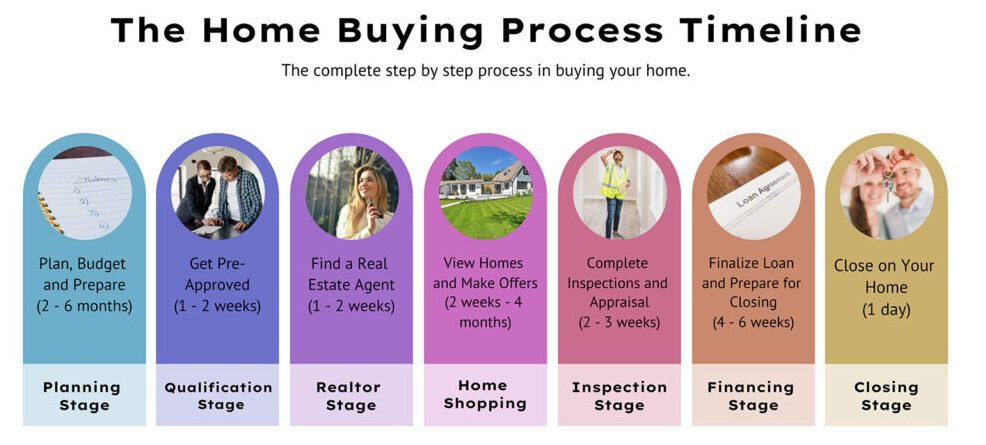If you’re ready to take the exciting step of homeownership, you might be asking: “How do I go from finding a house to getting a mortgage?” The process can seem overwhelming at first, but once you understand the steps, it becomes much more manageable.
In this post, we’ll walk you through the entire journey — from searching for a house to mortgage approval , closing, and beyond. Whether you’re a first-time buyer or upgrading your current home, this guide will help you navigate the process confidently.
Step 1: Determine Your Budget
Before you start looking at houses, know how much you can afford.
Use the 28/36 rule as a guide:
- 28% Rule : Your housing payment shouldn’t exceed 28% of your gross monthly income .
- 36% Rule : Total debt payments (including your mortgage) should stay under 36% of your gross income .
You can also use a mortgage calculator to estimate:
- Monthly payments
- Down payment needs
- Property taxes and insurance costs

Step 2: Get Pre-Approved for a Mortgage
Getting pre-approved is one of the most important early steps.
Here’s why:
- It tells you exactly how much you can borrow.
- Sellers are more likely to accept your offer.
- It speeds up the final loan approval process.
To get pre-approved, you’ll need to provide:
- Proof of income (pay stubs, W-2s)
- Bank statements
- Credit history
- Employment verification
A lender will then give you a pre-approval letter — which shows sellers you’re serious and financially qualified.
Step 3: Start House Hunting
Now that you know your budget, begin your search for the perfect home.
Use platforms like:
- Zillow
- Realtor.com
- Redfin
- Trulia
Search phrases like:
- “Homes for sale near me”
- “Houses with mortgage available”
- “Affordable homes in [City/Zip Code]”
Work with a real estate agent to tour homes, negotiate offers, and ensure the property meets your needs.
Step 4: Make an Offer and Go Into Escrow
Once you find the right house:
- Submit an offer to the seller.
- If accepted, the home goes into escrow — meaning the transaction is moving forward, and the home is no longer actively for sale.
During escrow:
- You’ll order a home inspection
- Your lender will order a property appraisal
- You’ll review title reports and finalize your mortgage application
Step 5: Finalize Your Mortgage
Your lender will now:
- Review your financial documents
- Confirm your employment and income
- Lock in your interest rate
- Prepare the final loan documents
At this stage, you’ll decide on your loan type :
- Fixed-rate mortgage (stable payments over time)
- Adjustable-rate mortgage (ARM) (lower initial rate, potential future increase)
- FHA, VA, or USDA loans (government-backed options for eligible buyers)
Step 6: Close on the House
Closing is the final step before you officially own the home.
What happens at closing:
- You sign all mortgage and title documents
- You pay closing costs (typically 2–5% of the loan amount)
- The lender funds the loan
- You receive the keys and become a homeowner
You can choose to close in person or online , depending on your lender and location.
Step 7: Move In and Start Paying Your Mortgage
After closing:
- You’ll begin making monthly mortgage payments
- You may set up an escrow account to cover taxes and insurance
- You’ll build equity over time as you pay down the loan
Keep track of your payments, maintain your home, and consider refinancing later if rates drop.
Types of Mortgages to Consider
| Fixed-Rate | Buyers who want stable payments |
| 15-Year Loan | Those who want to build equity quickly |
| 30-Year Loan | Most common — lower monthly payments |
| FHA Loan | First-time buyers with lower credit scores |
| VA Loan | Veterans and active-duty service members |
| USDA Loan | Buyers in rural areas with low-to-moderate income |
Final Thoughts
Going from house to mortgage doesn’t have to be confusing. With the right preparation — knowing your budget, getting pre-approved, and working with professionals — you’ll soon be holding the keys to your dream home.
The key is to stay informed , ask questions , and take things one step at a time . Before you know it, you’ll be settling into your new place and building long-term wealth through homeownership.
Frequently Asked Questions (FAQs)
Q1: Can I buy a house without a mortgage?
Yes, if you have enough cash to pay the full price — but most buyers use a mortgage due to high home prices.
Q2: How long does it take to get a mortgage after finding a house?
Typically 30–45 days from contract to closing, depending on lender workload and loan type.
Q3: What documents do I need to apply for a mortgage?
Common documents include ID, pay stubs, tax returns, bank statements, and proof of employment.

Join The Discussion